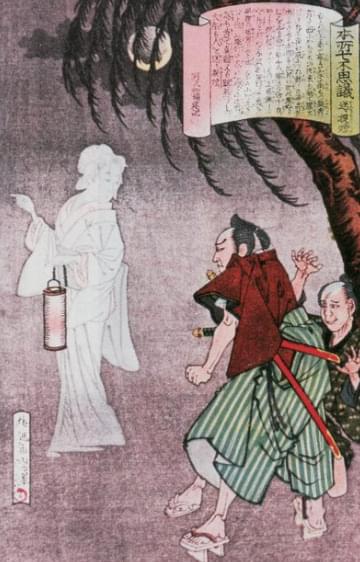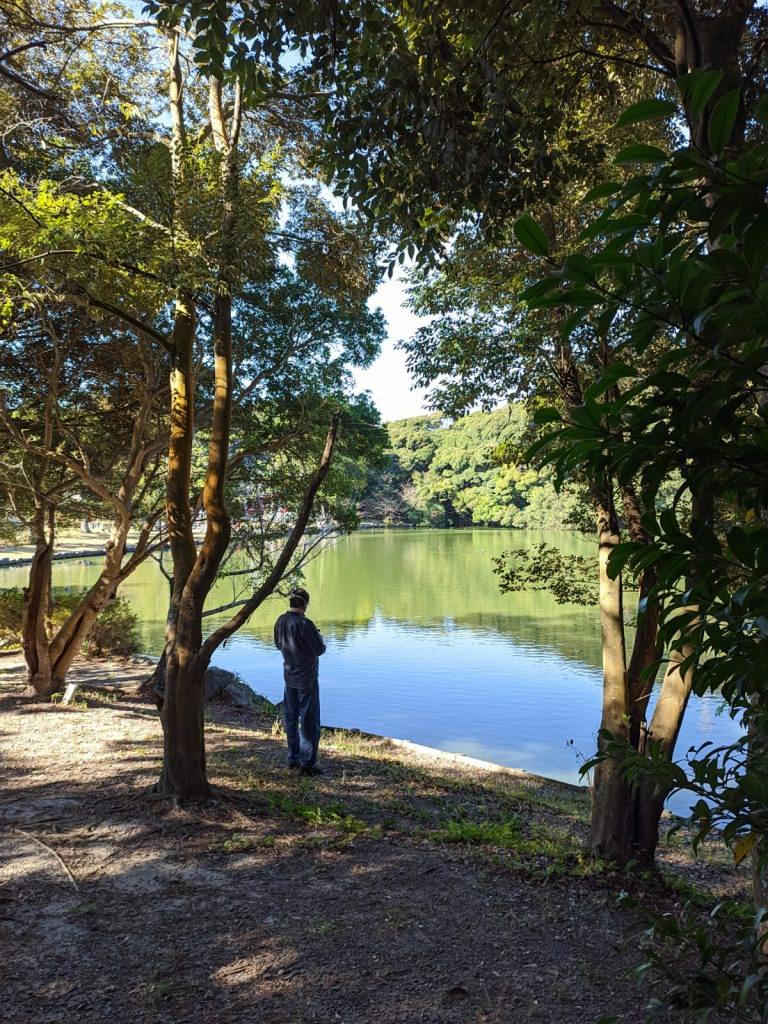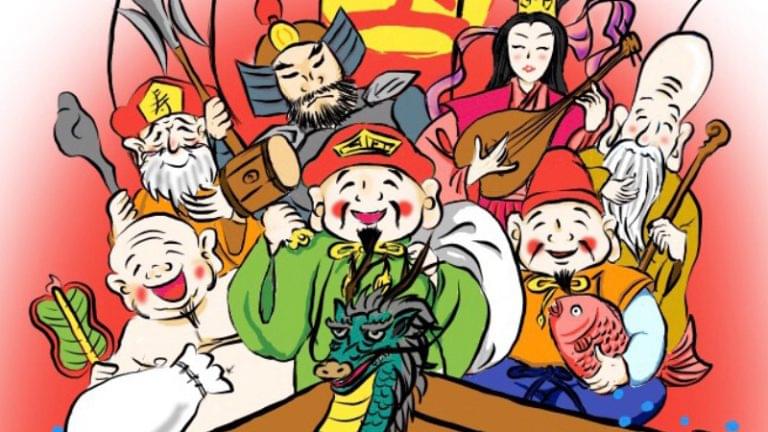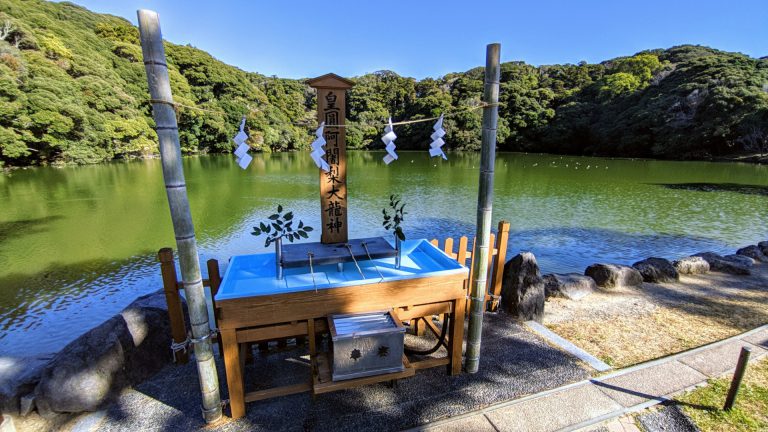A giant hairy foot crashing through the roof of an old house and demanding to be washed. A festive tanuki band that appears in the dead of night and lures you into parts unknown. These are just two of the Honjo Nanafushigi. Nanafushigi can be translated as seven wonders, but they’re more like seven mysteries. All over Japan you can find stories (old and new) of seven strange occurrences. As an introduction to my new idea of covering local legends and creepy tales, this month’s podcast is about nanafushigi. I’ll be talking about both the Honjo Nanafushigi and a little about how even all over Japan schools will often have their own nanafushigi that are more like local urban legends to spook and baffle the children.

Okuri Chochin. Beware of following a lantern at night!
Hey, hey everyone. Terrie here with another froggy background. Before I start, I want to thank everyone who has left a review of the show on iTunes. I get notifications when they come in and I read them right away. And when I’m feeling a little down, I read them again.
Kimon vs Kimono
The other day I got a very nice review with a question and I felt bad that I couldn’t answer. Then I realized I could answer right here. So that’s what I’m going to do. The question was… In one of the episodes you had the demon gate, kimon, which you explained as something bad. But I know there’s a traditional dress called the kimono. Are they related in any way?
Very good question. In this case, the word sounds similar, but the characters that make up the words are different. With kimon, the two kanji are ki, which means oni, demon, ogre, or devil. And mon, which means gate.
With kimono, again the word consists of two characters. And while the first is also ki, instead of oni or ogre, it’s a kanji having basically two meanings. One has to do with arriving, and the other has to do with clothing.
Kiru is a verb which actually means to wear. Now the second character of kimono is mono, and that usually means thing, object, or stuff. So together you get something like wearing thing or clothing stuff. But that doesn’t do justice to the awesome garment that is the kimono.
So while the two words do sound very similar, because their characters are different, they aren’t related. I’ll put this question up on the Uncanny Japan blog with some visuals so you can actually see the characters and what they look like. And that might help as well, to understand the differences. So thank you Japanfan1235, and I hope that answered your question.
Now onto today’s topic. I’m excited to share with you another idea I’m going to try out for the podcast. I’ve already told my patrons and the response seems pretty good. So let me share it here and see what you all think.
Just to reiterate, right now I have the regular episodes that are about the interesting, curious, and creepy parts of Japanese culture. Things like Buddhist Hells, the God of Smallpox, and sometimes an urban legend or two like, what did I do, Kuchisake Onna, the slit mouthed woman, and Jinmengyo, the human faced carp. Then, I recently decided to occasionally do a story time episode, which is me reading some Japanese folktale with a nice spooky music bed. Right now I’m doing the works of Lafcadio Hearn.
Now, do note that these stories are different than the ones I do as a Patreon reward. The Patreon stories can be something I found, but also often it’s something I found and I’ve translated and then reimagined. Even I sometimes do one of my own stories.
This month I’m going to read one from my book, The Carp Faced Boy. It’s a story called Sasa’s Rouged Cheeks, Sasa’s Reddened Lips. I’ve always really liked this story. It’s about a female oni and a man who has survived the smallpox god minus his looks and his sight. It asks questions about what is love, can we really change, how much are we willing to sacrifice for the person we love, and there’s also this really cool fight scene between the female oni and the entire male population of this little village. So that’s going to be this month on Patreon.
What are Nanafushigi?
Anyway, back to my idea. So I’ve decided to add to the mix, the regular episodes and the stories, some local legends and creepy tales. As an intro into this idea, I’m going to talk today about nanafushigi. It’s often translated as Seven Wonders. When I think of Seven Wonders, I think about the Seven Wonders of the World, right?
There are quite a few lists there. You have the Seven Wonders of the Ancient World, the Seven Natural Wonders of the World. There’s even the Seven Wonders of the Underwater World. So I googled the Seven Wonders of Japan, and if you do that, you get a list, or sometimes different lists, but they include things like Kiyomizu Temple in Kyoto, Himeji Castle, the Peace Park in Hiroshima, Kinkaku-ji, the Golden Pavilion, Mount Fuji, the Shinkansen, and ramen.
But that’s not what I’m going to talk about. The nanafushigi I’m talking about, and what I think about when I hear the word, isn’t so much wonders like something that is awe inspiring, but instead it’s something that’s creepy and eerie and probably a little disturbing. Less wonders and more mysteries, so that’s why I’m going to call them the Seven Mysteries.
All over Japan, cities, prefectures, and even schools have their own nanafushigi or Seven Mysteries. Some are more like urban legends, while others are quite old and have been told for generations. So let me explain by giving you an example.
Honjō is an old Edo era name for an area in Tokyo called Sumida. One of the things it’s known for is its nanafushigi or Seven Mysteries. As a matter of fact, the Honjō Nanafushigi are so well known that there have been rakugo stories dedicated to them, ukiyoe woodblock prints carved of them, and an old movie or two about them. Even today, if you go to Sumida, you can visit the different sites of the nanafushigi. It’s much more urban now compared to back in the day, so the mood isn’t exactly right, but still, if you do your research, you can find statues and plaques on the spots where the mysterious occurrences took place.
Honjo Nanafushigi
So what are these mysterious occurrences? Let me give you a brief example of the Nanafushigi of Honjō. Number one is Oitebori. Imagine you have gone fishing on a dark, drizzly night, and you find you catch a lot of fish. You’re thrilled with your good luck, but since it’s late and you’re tired, you shoulder your bag full of fish and you head home. There isn’t another person in sight, so you nearly jump out of your skin when you hear a croaky voice coming from what sounds like the middle of the moat, saying, leave them, leave them. Frightened, you run home only to find, after you’ve made it safely, that your bag is completely empty. Even now, there’s a statue in Sumida of a kappa with two fish on its back, indicating the incident.
Okuri Chochin
Next, we have Okuri Chochin. Here, for some reason or another, you’re walking home alone late at night with no lantern. You’re frightened and anxious because it’s so dark and there’s not another person in sight. Suddenly, up ahead, you see a light. It’s the bobbing glow of another lantern. Thank goodness. You break into a jog to catch up with the lantern carrier, but you’re never able to do so. They’re always a little bit faster than you are, no matter how fast you run.
Okuri Hyoshigi
Then, there’s the story of Okuri Hyōshigi. I need to explain real quick an interesting old custom that is actually still performed sometimes in my neighborhood, and I imagine also in other rural parts of Japan. That is, during the dry months, men go out with two small blocks of wood called hyōshigi and clap them together, chanting loudly, hi no yoji, which basically means mind your fires. The men walk slowly, clapping and chanting all up and down the streets.
Now, this nanafushigi, Okuri Hyōshigi, told of how even when the men would stop clapping the wood, they could hear behind them the same clapping sound, almost as if someone were following them. Some believed it was an echo, but the phenomenon still happened even on rainy nights.
Akarinashi Soba
The next mystery of Honjō is Akarinashi Soba, the lightless soba seller. Here is a tale about a small outdoor soba stall, where every night the noodle stand would appear, but no one would be there to sell the noodles. Still, the andon oil lamp would be lit and stay lit all night long, with no one tending it or adding oil. If you approached the stand, you would have bad luck.
Kiezu No Andon
There’s another story that states the opposite. It’s called Kiezu No Andon, the oil lamp that doesn’t go out. Here there is an oil lamp, and it has enough oil, but no matter how hard someone tries to light it, the fire just goes out, doesn’t light. This is also very unlucky.
Ashiarai Yashiki
Next, Ashiarai Yashiki. This one is kind of fun. It’s the legend about how at night a giant foot would come crashing through the ceiling of some home. The foot was large, dirty, and covered in bristling thick hair. A booming voice would say, Ashiarai, or wash my foot. If the people in the house did as they were told, everything would be okay. If not, the foot would get angry and go stomping around, making a wreck of everything.
Ochiba Shinai
Then there is Ochiba Shinai Shii No Ki. In this tale, a certain Matsuura family lived in a large estate in the Honjo area. There on their land stood a very grand oak tree with thousands of acorns. However, no matter the weather, the tree never shed a single leaf. This freaked out the Matsuura family, and eventually they moved.
Kataba No Ashi
Next, Kataba No Ashi. This one is a bit dark and sad. There once was a woman named Okoma who attracted the attention of a man named Tozo. Tozo made his intentions known again and again, approaching Okoma and professing his love. Okoma, though, wasn’t interested in him and politely refused. Tozo grew so angry and frustrated that one night on the Ryokoku Bridge he lay in wait for the beautiful Okoma.
While she was crossing the bridge, he attacked and killed her, cutting off one arm and leg with his sword and throwing them into the river below. It is said that from then, the reeds in the water would only tassel on one side.
Tanuki-bayashi or Baka-bayashi
And the last one is Tanuki-bayashi or Baka-bayashi. A hayashi or bayashi is a traditional Japanese like a band or a musical accompaniment. You often hear them during festivals. There’s flute and taiko drums. In this tale, imagine you’re walking alone at night when you hear some lively drum and flute playing. That’s odd. There aren’t any festivals this time of year, and it’s very, very late. But you’re intrigued, so you follow the music thinking you’re getting closer. But much like the Okuri Chochin story, you never really catch up. Finally, you end up in a place you’ve never been before absolutely lost. It’s believed that the trickster tanuki are the ones responsible for luring unsuspecting people away in this tale.
Now, if you were counting, you would have noticed that there were eight and not seven mysterious things in Honjō. Actually, there are even a couple more. That tends to happen a lot with the older nanafushigi. The stories have been passed down for so long that invariably new twists and tales are added. It depends on whose version of the nanafushigi you hear as to which seven you get.
Nanafushigi in Schools
Another interesting thing about nanafushigi is that sometimes they’re not so old, and they’re simply very local urban legends. When my son was in school, both his elementary school and his junior high school had their own nanafushigi. And all over Japan, a lot, if not all schools, I think have them. Students gossiping about some frightful thing that happened to someone, somewhere, sometime. Here are a couple examples of the mysteries I heard from Julyan.
First, he told me they all seemed to happen at night or when everyone had left the school building. There was something about the number of stairs going up a staircase being different from the number of stairs when you turned around and went back down. Something about a picture in the music room of Beethoven where his eyes lit up and followed you as you walked across the room.
And then there was something about a bathroom. There always seems to be some scary story about some stall in the bathroom that won’t open and what will happen if you go inside or what happened there and why it doesn’t open. What I distinctly remember, though, is asking him what all seven were. I was intrigued, and I wanted to know more. But Julyan matter of factly told me that no one knows all seven. I asked why, and he told me that because once you learn the seventh nanafushigi, you die. Okay. So, don’t worry about that, because those were Julyan’s school, probably the seventh nanafushigi as far as I know, and I won’t be doing those.
Enshu Nanafushigi of Shizuoka
Instead, let me segue back into my idea. I’m really lucky that my area of Japan, Shizuoka, has its own nanafushigi. They’re called Enshu Nanafushigi. But like I was just telling you, these stories have been told and retold for so long that sometimes there’s quite a few more than seven. And it seems like with the seven mysteries of Enshu, that’s exactly the case.
Just from what I found now, I count anywhere between 13 and 22 strange occurrences. But that’s okay, because I’m planning on going and visiting every single strange spot, spend the day recording, taking photos, researching, and asking the locals questions. Then I’ll put it all together and share it with you guys here. I’m thinking of doing one every couple months or so. As a matter of fact, I’ve already got one lined up for the next show. It involves a kimono clad woman, an unborn baby, a horrible man with a sword, and a ghost. Oh, and also candy. So I’ll get started on that one as soon as I get this one up.
So that’s all for today, and thank you all for listening. I will talk to you again real soon. Bye bye.
Credits
Intro and outro music by Julyan Ray Matsuura






